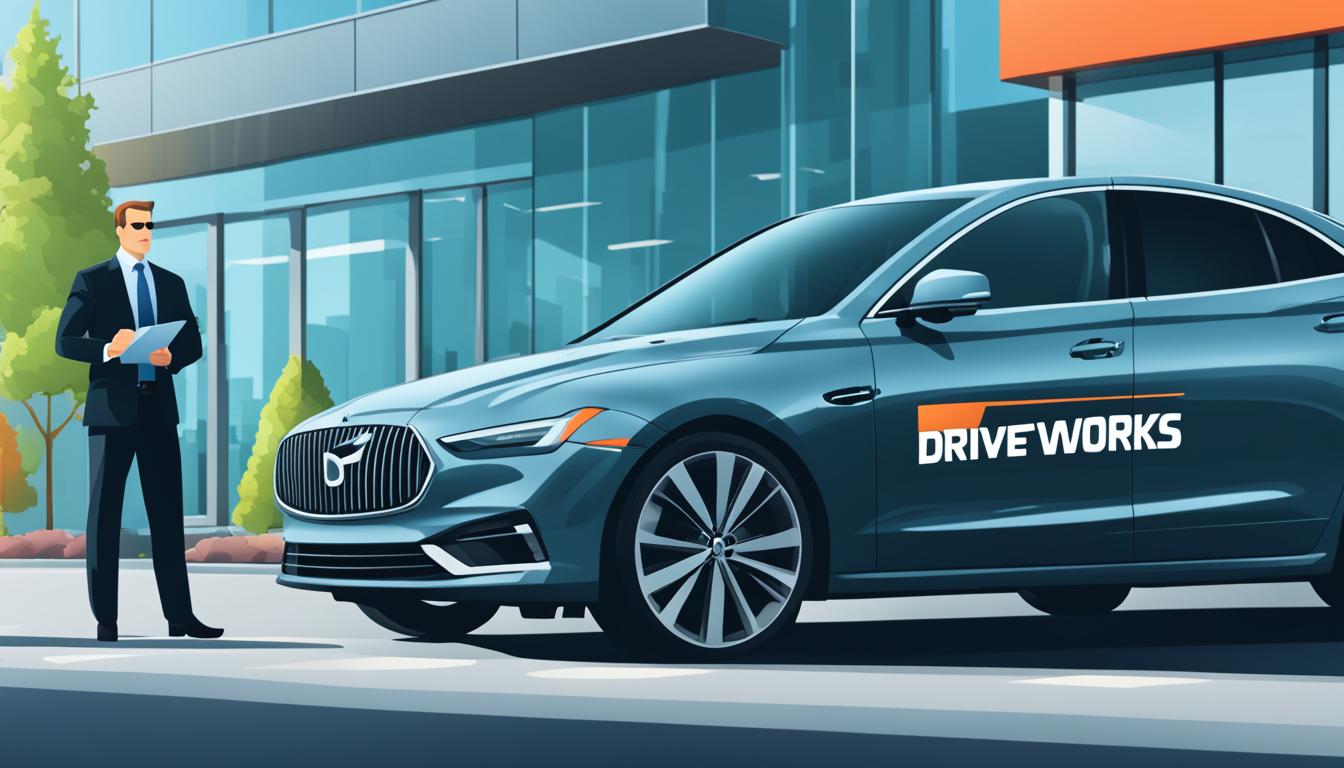Did you know that the minimum age requirement for a Class A and B commercial driver’s license (CDL) is 18 years, while for a Class C CDL, it is 16 years? This fact highlights the accessibility of starting a private transportation services business for entrepreneurs of various ages. As the demand for personalized and convenient transportation solutions continues to grow, launching a private driver business can be a lucrative and rewarding venture.
To embark on this entrepreneurial journey, it’s essential to understand your target market and the specific services you want to offer, such as shuttling, wedding transportation, luxury vehicles, or airport services. By identifying a niche that aligns with your interests and expertise, you can differentiate your business from competitors and attract loyal customers.
Setting up a solid legal foundation is crucial for operating your private driver business successfully. This includes forming an LLC, obtaining necessary licenses and permits, and securing comprehensive insurance coverage for your vehicles and business. Developing a well-crafted business plan is equally important, as it serves as a roadmap for your venture, outlining your goals, strategies, and financial projections.
Financing your startup costs and purchasing equipment may require exploring various options, such as business loans, investors, or personal savings. Estimating your expenses accurately and securing appropriate funding will help establish a strong financial foundation for your private driver business.
To build a loyal customer base, prioritize a customer-centric approach that focuses on providing exceptional service and maintaining transparency in communication and pricing. Acquiring new customers can be achieved through a combination of strategies, including building a professional website, leveraging social media platforms, and seeking referrals from satisfied clients.
Establishing a profitable pricing strategy is key to the long-term success of your business. Conduct thorough research on your costs, desired profit margins, and competitors’ prices to develop a pricing structure that ensures sustainability and growth.
When hiring drivers, prioritize candidates with excellent driving records, strong customer service skills, and professional demeanor. Provide comprehensive training and ongoing support to ensure your team consistently delivers exceptional service and represents your brand positively.
As you navigate the challenges of starting and growing your private driver business, be aware of common mistakes, such as falling victim to fraud, neglecting professionalism, or focusing on short-term gains over long-term success. By maintaining a cautious and strategic approach, you can position your business for lasting success in the dynamic transportation industry.
Key Takeaways
- Understand your target market and choose a niche that aligns with your interests and expertise.
- Set up a solid legal foundation by forming an LLC, obtaining necessary licenses and permits, and securing comprehensive insurance coverage.
- Develop a well-crafted business plan that outlines your goals, strategies, and financial projections.
- Explore financing options, such as business loans, investors, or personal savings, to cover startup costs and purchase equipment.
- Prioritize a customer-centric approach and acquire new customers through a professional website, social media, and referrals.
- Establish a profitable pricing strategy that ensures sustainability and growth.
- Hire and train reliable drivers who consistently deliver exceptional service and represent your brand positively.
Understanding Your Target Market and Customers
To launch a thriving private driver business, it’s essential to gain a deep understanding of your target market and the unique needs of your customers. By identifying the most significant opportunities in your city and focusing on a specific niche, you can position your business for success and differentiate yourself from competitors.
Identifying the Biggest Opportunities in Your City
Begin by researching the transportation landscape in your city to uncover the most promising opportunities. Consider factors such as popular destinations, underserved areas, and peak demand times. Some potential opportunities may include:
- High-demand routes to wineries, wedding venues, or airports
- Corporate event transportation for businesses and conferences
- Late-night rides for concert-goers and nightlife enthusiasts
- Specialized services for seniors or individuals with disabilities
Choosing Your Niche: Shuttling, Wedding Transportation, Luxury Vehicles, or Airport Services
Once you’ve identified the key opportunities in your city, it’s time to choose a niche that aligns with your interests, expertise, and target market. Specializing in a specific area allows you to build a strong reputation, attract loyal customers, and tailor your services to meet their unique needs. Consider the following niches:
- Shuttling services for group events, tours, or daily commutes
- Wedding transportation, offering elegant vehicles and attentive service
- Luxury vehicle services for high-end clientele and special occasions
- Airport transportation, providing reliable rides to and from the airport
When selecting your niche, consider the demographics of your target market, such as age, income level, and lifestyle preferences. Tailor your services, pricing, and marketing strategies to appeal to your ideal customers and effectively meet their transportation needs. By focusing on a well-defined niche and deeply understanding your customers, you can create a strong foundation for growth and establish a competitive edge in the private driver industry.
Setting Up the Legal Foundation of Your Business
Establishing a solid legal foundation is crucial when starting your private driver business. By taking the necessary steps to form a legal entity, obtain licenses and permits, and secure appropriate insurance coverage, you can protect your personal assets, comply with regulations, and instill confidence in your customers.
Forming a Legal Entity
One of the first steps in setting up your legal foundation is forming a legal entity, such as an LLC. An LLC provides personal liability protection, separating your business assets from your personal assets. This means that if your business faces legal issues or financial difficulties, your personal property and savings will be safeguarded. Additionally, forming an LLC can help establish credibility with customers and lenders, demonstrating your commitment to operating a professional business. To form an LLC, you’ll need to choose a business name, file articles of organization with your state, and obtain an Employer Identification Number (EIN) from the IRS for tax purposes.
Obtaining Necessary Licenses and Permits
To operate legally, your private driver business must acquire various licenses and permits. The specific requirements may vary depending on your location and the services you offer. Some common licenses and permits include:
- Commercial driver’s license (CDL) for your drivers
- Department of Transportation (DOT) authorization for interstate transportation
- Transportation Charter Permit (TCP) for operating a for-hire transportation service
- Airport permits for picking up and dropping off passengers at airports
Research the licensing requirements in your area and ensure that both your business and your drivers have all necessary documentation before beginning operations.
Getting Insurance for Your Business and Vehicles
Comprehensive insurance coverage is essential for protecting your business and vehicles from potential risks and liabilities. Work with an experienced insurance agent to determine the appropriate coverage levels for your specific needs. Some key types of insurance to consider include:
- Commercial auto insurance to cover damages and injuries caused by your vehicles
- Liability insurance to protect against claims of negligence or wrongdoing
- Workers’ compensation insurance if you have employees
- Property insurance for your office space and equipment
By investing in the right insurance policies, you can safeguard your business from financial losses and demonstrate your commitment to responsible operations.
Setting up a strong legal foundation takes time and effort, but it is a critical step in launching a successful private driver business. By forming an LLC, obtaining necessary licenses and permits, and securing comprehensive insurance coverage, you can minimize risks, comply with regulations, and create a solid platform for growth.
Developing a Comprehensive Business Plan
A well-crafted business plan is essential for guiding your private driver business to success. Start by defining your company’s vision and mission, outlining your short-term and long-term goals. Conduct a thorough market analysis to identify your target customers, assess the competition, and determine your unique selling proposition. This will help you create a solid foundation for your operational plan and marketing strategies.
- Outline your business structure, staffing requirements, and day-to-day processes in your operational plan.
- Create detailed financial projections that estimate your start-up costs, operating expenses, revenue potential, and break-even point.
- Develop a marketing plan that showcases your strategies for attracting and retaining customers, such as building a professional website, leveraging social media, and forming partnerships with complementary businesses.
As you refine your business plan, consider seeking feedback from mentors, industry experts, or potential investors. Their insights can help you identify areas for improvement and ensure your plan is comprehensive and realistic. Remember, a well-crafted business plan will serve as a roadmap for your private driver business, helping you stay focused, make informed decisions, and secure funding if needed.
Securing Financing and Purchasing Equipment
Starting a private driver business requires a significant investment in vehicles, insurance, licensing, and other equipment. According to recent statistics, over 3.3 million people are directly employed as truck drivers in the U.S., and 91.5% of transportation companies operate six or fewer commercial trucks. To secure the necessary financing for your business, you’ll need to carefully estimate your start-up costs and explore various funding options.
Estimating Start-up Costs and Operating Expenses
Begin by estimating your start-up costs, which may include:
- Vehicle purchase or leasing
- Commercial insurance premiums
- Licensing and permit fees
- Office supplies and equipment
- Marketing expenses
Don’t forget to factor in ongoing operating expenses, such as vehicle maintenance, fuel, payroll, and utilities. By having a clear understanding of your financial needs, you can make informed decisions about securing the appropriate financing for your business.
Exploring Financing Options: Business Loans, Investors, and Personal Savings
There are several financing options available for private driver businesses, including:
- Business loans from banks or credit unions
- Angel investors or private individuals offering funding in exchange for equity
- Crowdfunding platforms for raising smaller amounts from a large number of backers
- Personal savings invested in the business (be sure to create a separate business account)
When considering business loans, keep in mind that short-term loans for transportation businesses typically must be repaid in under 18 months, while long-term loans might take 10 years or more to repay. The Small Business Administration (SBA) offers several loan programs, such as SBA 7(a) loans, which can be used for various business needs and can go up to $5 million, and SBA 504 loans, which are aimed at upgrading infrastructure to create jobs or boost the local economy.
Equipment loans are another good funding option for transportation companies looking to purchase, repair, or upgrade vehicles. Business credit cards offer revolving credit lines with an agreed-upon credit limit, while merchant cash advances provide quick cash advances based on future credit and debit card transactions. Invoice factoring companies can also help by purchasing unpaid invoices from businesses.
When purchasing vehicles, compare the costs and benefits of buying versus leasing, and choose reliable models that align with your target market’s preferences. By carefully estimating your costs and securing appropriate financing, you can establish a solid financial foundation for your private driver business.
Creating a Customer-Centric Approach
To build a thriving private driver business, it’s essential to prioritize a customer-centric approach that focuses on delivering exceptional service and fostering loyal clients. By consistently putting your customers first and going above and beyond to meet their needs, you can differentiate your business from competitors and establish a strong reputation in the industry.
Asking for Feedback and Referrals
One of the most effective ways to gauge customer satisfaction and identify areas for improvement is by regularly asking for feedback after each trip. Encourage your clients to share their honest opinions about their experience, and use this valuable insight to refine your services and address any concerns. When you receive positive feedback, seize the opportunity to ask satisfied customers for referrals. Word-of-mouth recommendations from happy clients can be a powerful driver of new business, helping you expand your customer base and grow your company.
Maintaining Transparency in Communication and Pricing
To build trust and credibility with your customers, it’s crucial to maintain transparency in all aspects of your communication and pricing. Clearly explain your rates, policies, and any additional fees upfront to avoid surprises or misunderstandings. Be responsive to customer inquiries and concerns, providing prompt and professional answers to their questions. If any issues arise, strive to resolve them quickly and efficiently, keeping your clients informed throughout the process. By being open, honest, and proactive in your communication, you can create a foundation of trust and loyalty with your customers.
Prioritizing Punctuality and Safety
In the private driver industry, punctuality and safety are paramount to providing exceptional customer service. Ensure that your drivers arrive at least 15 minutes early for each trip, allowing ample time for traffic or unexpected delays. Implement strict safety protocols, such as:
- Conducting regular vehicle inspections to maintain optimal performance and reliability
- Performing thorough background checks on all drivers to ensure a safe and trustworthy team
- Enforcing adherence to local traffic laws and promoting defensive driving techniques
By prioritizing punctuality and safety, you demonstrate your commitment to your clients’ well-being and satisfaction, setting your business apart from the competition.
By consistently delivering high-quality service, maintaining transparent communication, and prioritizing punctuality and safety, you can create a customer-centric approach that sets your private driver business up for success. Putting your clients first and continuously striving to exceed their expectations will help you build a loyal customer base and establish a strong reputation in the industry.
Acquiring New Customers and Growing Your Business
As a private driver business owner, your success hinges on your ability to consistently acquire new customers and foster steady growth. By implementing a multi-faceted approach to customer acquisition, you can expand your client base and establish a strong presence in your local market.
Building a Professional Website
In today’s digital age, having a professional website is essential for attracting new customers and showcasing your business. Invest in website development that highlights your unique value proposition, services, and pricing. Optimize your site for search engines by incorporating relevant keywords, such as “private driver services” and “luxury transportation,” to improve your visibility in online searches. Include clear calls-to-action throughout your site, encouraging visitors to book your services or request more information.
Leveraging Social Media Platforms
Social media marketing is a powerful tool for connecting with potential customers and building brand awareness. Create profiles on platforms like Facebook, Instagram, and LinkedIn, and share engaging content that showcases your expertise and highlights your services. Post customer testimonials, behind-the-scenes photos, and industry news to attract followers and establish your business as a trusted authority in the private driver industry. Engage with your audience by responding to comments and messages, and consider running targeted ads to reach new customers in your area.

Networking and Seeking Referrals
Building relationships with other businesses and professionals in your community can be a valuable source of new customers and growth opportunities. Attend local networking events, such as business conferences or wedding expos, to meet potential partners and clients face-to-face. Join professional organizations related to your niche, such as transportation associations or hospitality groups, to expand your network and stay informed about industry trends.
Don’t underestimate the power of referrals from your existing customer base. Encourage satisfied clients to refer their friends and colleagues to your business by implementing a referral program that rewards them for successful referrals. Consider offering discounts on future rides or gift cards as incentives for referrals that lead to new business.
By consistently focusing on customer acquisition through website development, social media marketing, networking, and referrals, you can foster steady growth and establish a strong reputation in your local private driver market.
Establishing a Profitable Pricing Strategy
Developing a profitable pricing strategy is essential for the success and growth of your private driver business. To ensure you’re setting the right prices, start by thoroughly analyzing your costs, including expenses related to vehicles, insurance, fuel, maintenance, and driver compensation. Aim to determine a profit margin that will allow you to sustain and expand your business, typically falling within the range of 20-40%.
Conducting a competitive analysis is crucial to ensure your pricing remains competitive while still covering your costs and achieving your desired profit margins. Research the prices set by other private driver businesses in your area and consider how your services compare in terms of quality, luxury, and specialized expertise. This information will help you make informed decisions about your own pricing strategy.
One approach to consider is value-based pricing, which focuses on the perceived value your services provide to customers rather than solely on your costs. By offering exceptional service, luxury vehicles, or specialized expertise, you can justify charging premium rates that reflect the added value you bring to your clients. This pricing strategy can help you differentiate your business from competitors and attract a loyal customer base willing to pay for superior service.
As you implement your pricing strategy, it’s essential to monitor and adjust your rates regularly based on various factors, such as:
- Market conditions
- Demand fluctuations
- Customer feedback
Staying flexible and adaptable in your pricing approach will help you remain competitive and profitable in the long run. Another option to consider is dynamic pricing, which involves adjusting rates based on factors like time of day, weather conditions, or special events. By strategically varying your prices, you can optimize your revenue potential and better align with customer demand.
Ultimately, establishing a well-researched and flexible pricing strategy is key to maximizing your profitability while remaining competitive in your market. By carefully analyzing your costs, conducting thorough competitive analysis, and considering value-based and dynamic pricing approaches, you can set prices that support the long-term success of your private driver business.
Hiring and Managing the Right Drivers
As the owner of a private driver business, assembling a team of reliable, skilled, and customer-focused drivers is essential to your success. The quality of your driver hiring and management processes directly impacts the level of service you provide and the reputation you build in the industry. By implementing a thorough driver selection and training program, you can ensure that your drivers consistently deliver exceptional experiences to your clients.
Conducting Reference Checks and Test Rides
When evaluating potential drivers, it’s crucial to conduct comprehensive reference checks to verify their experience, reliability, and professionalism. Reach out to previous employers and inquire about the candidate’s driving record, punctuality, and customer service skills. To gain a firsthand understanding of their abilities, arrange test rides where you assume the role of a customer. During these rides, assess their driving skills, navigation proficiency, and ability to interact with passengers in a friendly and professional manner. By thoroughly vetting your drivers, you can build a team that aligns with your company’s values and standards.
Providing Thorough Training and Onboarding
Once you’ve hired your drivers, invest in comprehensive training and onboarding to ensure they are well-prepared to represent your brand. Your driver training program should cover a wide range of topics, including:
- Company policies and procedures
- Vehicle maintenance and safety protocols
- Customer service best practices
- Emergency response and incident reporting
- Navigation and route optimization techniques
Consider implementing ongoing training initiatives to keep your drivers updated on industry trends, regulatory changes, and new technologies. Regular training not only enhances your drivers’ skills but also demonstrates your commitment to their professional development and the overall success of your business.
To maintain a high standard of service, regularly monitor your drivers’ performance through customer feedback, GPS tracking, and ride reviews. Promptly address any issues that arise and provide constructive feedback to help your drivers continually improve. By carefully selecting, training, and managing your drivers, you can foster a team that consistently delivers exceptional service, enhances customer loyalty, and positively represents your private driver business.
How to Start a Private Driver Business: Avoiding Common Mistakes
As you embark on your journey to start and grow a successful private driver business, it’s crucial to be aware of common mistakes that can hinder your progress. By maintaining a focus on professionalism, long-term thinking, and fraud prevention, you can position your business for sustainable growth and success.
When receiving affiliate work, ensure that you are paid on time to maintain a healthy cash flow. Consider requiring credit card payments to minimize the risk of non-payment and protect your business from financial setbacks. Be cautious of customers who seem too good to be true, as they may be attempting to commit fraud. Always verify their identity by requesting a copy of their ID and credit card, and ensure that the information matches to prevent falling victim to fraudulent activities.

As the owner of your private driver business, it’s essential to be confident in your decision-making and leadership abilities. While seeking advice and learning from others can be valuable, trust your instincts and make choices that align with your goals and values. Remember that building strong relationships and maintaining a professional reputation are key to long-term success in the transportation industry. Avoid burning bridges or engaging in unethical practices, as word can spread quickly and damage your business’s reputation.
When making decisions for your private driver business, always think long-term. Prioritize sustainable growth and customer satisfaction over short-term gains. By maintaining a focus on professionalism and integrity, you can build a solid foundation for your business and attract loyal customers who appreciate your commitment to excellence.
To avoid common mistakes and set your private driver business up for success, keep the following tips in mind:
- Ensure timely payments for affiliate work and consider requiring credit card payments
- Be vigilant against fraudulent customers by verifying their identity
- Trust your instincts and make decisions that align with your goals and values
- Prioritize building strong relationships and maintaining a professional reputation
- Think long-term and focus on sustainable growth and customer satisfaction
By being aware of these common pitfalls and maintaining a focus on professionalism and integrity, you can position your private driver business for lasting success in a competitive industry.
Providing Exceptional Customer Service
In the private driver industry, delivering exceptional customer service is the key to building a loyal client base and establishing a positive reputation. To achieve this, it’s essential to train your drivers to go above and beyond for clients, anticipating their needs and preferences. This personalized service may include offering bottled water, helping with luggage, or providing local recommendations.
Encourage your drivers to build rapport with clients while maintaining professional boundaries. According to top experts selected by the community from 56 contributions, communication skills are imperative for a customer service role in transportation services. By fostering open communication and actively listening to clients’ needs, your drivers can create a positive and lasting relationship with customers.
Going Above and Beyond for Clients
To truly excel in customer service, your drivers should be proactive in addressing clients’ needs. This may involve:
- Offering complimentary amenities such as phone chargers or Wi-Fi
- Providing personalized recommendations for local attractions or restaurants
- Assisting with special requests, such as making dinner reservations or arranging for additional transportation
By consistently going the extra mile, your drivers can create memorable experiences that will keep clients coming back and referring others to your business.
Handling Complaints and Resolving Issues
Even with the best intentions, complaints and issues may arise. When a customer raises a concern, it’s crucial to address it promptly and with empathy. Problem-solving skills in transportation services include utilizing critical thinking and logic to find a satisfactory resolution. Listen actively to the customer’s concerns, apologize for any inconvenience, and work diligently to find a solution.
After resolving the issue, follow up with the customer to ensure their satisfaction and demonstrate your commitment to their experience. Consider implementing a customer feedback system, such as post-ride surveys or review requests, to gather insights into areas for improvement. Regularly review this feedback with your team and use it to inform your training and service offerings.
By consistently delivering personalized, attentive service and proactively addressing customer concerns, you can differentiate your private driver business and foster long-term client loyalty. Remember, in the transportation industry, complaint resolution and client satisfaction are essential for building a successful and thriving business.
Staying Compliant and Adaptable in a Changing Industry
To thrive in the ever-evolving private driver industry, your business must remain compliant with regulations while embracing adaptability. As new industry standards emerge, it’s crucial to stay informed and adjust your operations accordingly. Regularly review and adhere to all relevant federal, state, and local regulations, such as driver licensing requirements, vehicle safety standards, and insurance mandates. Joining industry associations and attending conferences can help you stay current on regulatory changes and best practices, ensuring your business maintains compliance.
Keeping Up with Regulations and Industry Standards
In addition to compliance, adaptability is key to long-term success in the private driver industry. As technology continues to advance, be open to adopting new tools and platforms that can streamline your operations and enhance the customer experience. Invest in reliable dispatch software, GPS tracking systems, and mobile apps that allow customers to easily book and track their rides. By staying up-to-date with technological innovations, you can improve efficiency, reduce costs, and provide a seamless transportation experience for your clients.
Embracing Technology and Innovation
Another aspect of adaptability is exploring partnerships with complementary businesses, such as hotels or event venues, to expand your customer base and offer integrated transportation solutions. Stay open to experimenting with new services or pricing models that align with evolving customer preferences and market demands. By remaining compliant, adaptable, and technologically savvy, you can position your private driver business for sustainable growth and success in an industry that is constantly transforming.
FAQ
How do I identify the biggest opportunities for my private driver business in my city?
What legal requirements do I need to fulfill to start a private driver business?
How do I create a comprehensive business plan for my private driver business?
What are the financing options available for starting a private driver business?
How can I provide exceptional customer service in my private driver business?
What are some effective ways to acquire new customers for my private driver business?
How do I develop a profitable pricing strategy for my private driver business?
What should I look for when hiring drivers for my private driver business?
How can I stay compliant and adaptable in the ever-changing private driver industry?
What are some common mistakes to avoid when starting a private driver business?
Author
-

Lucas Martinez is an accomplished entrepreneur with a passion for startups. He has launched and scaled multiple businesses, providing pragmatic advice on starting and growing a business.
View all posts



